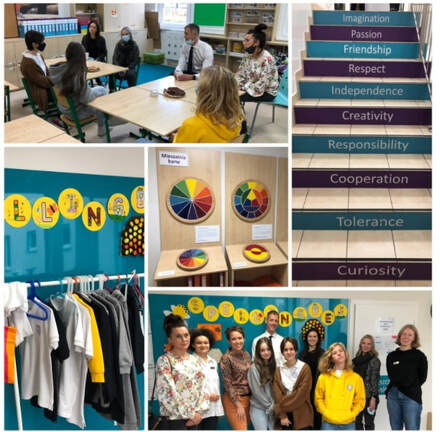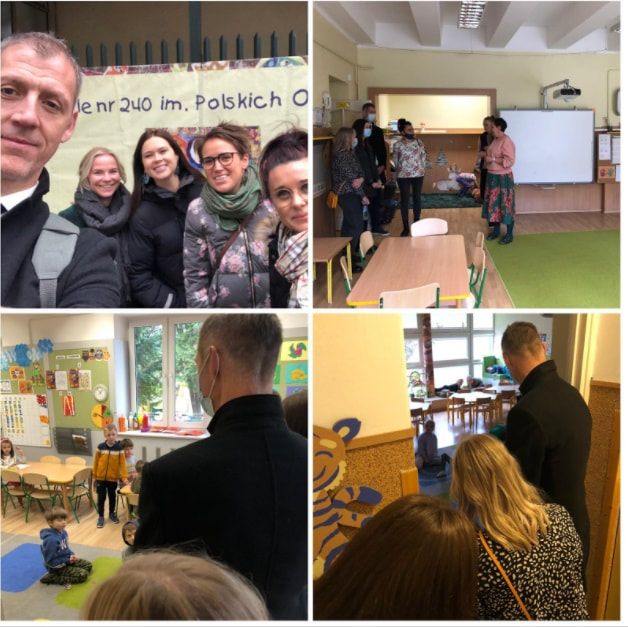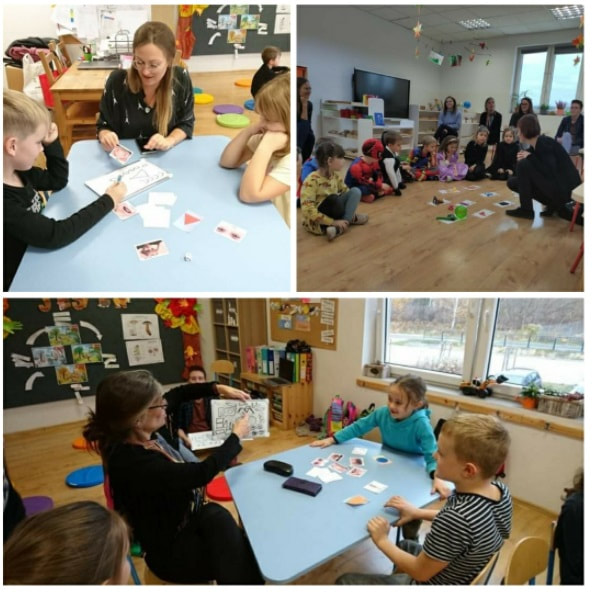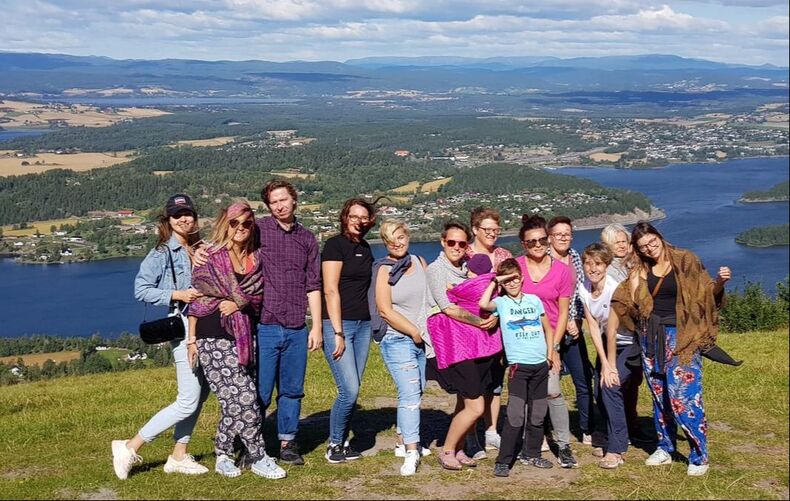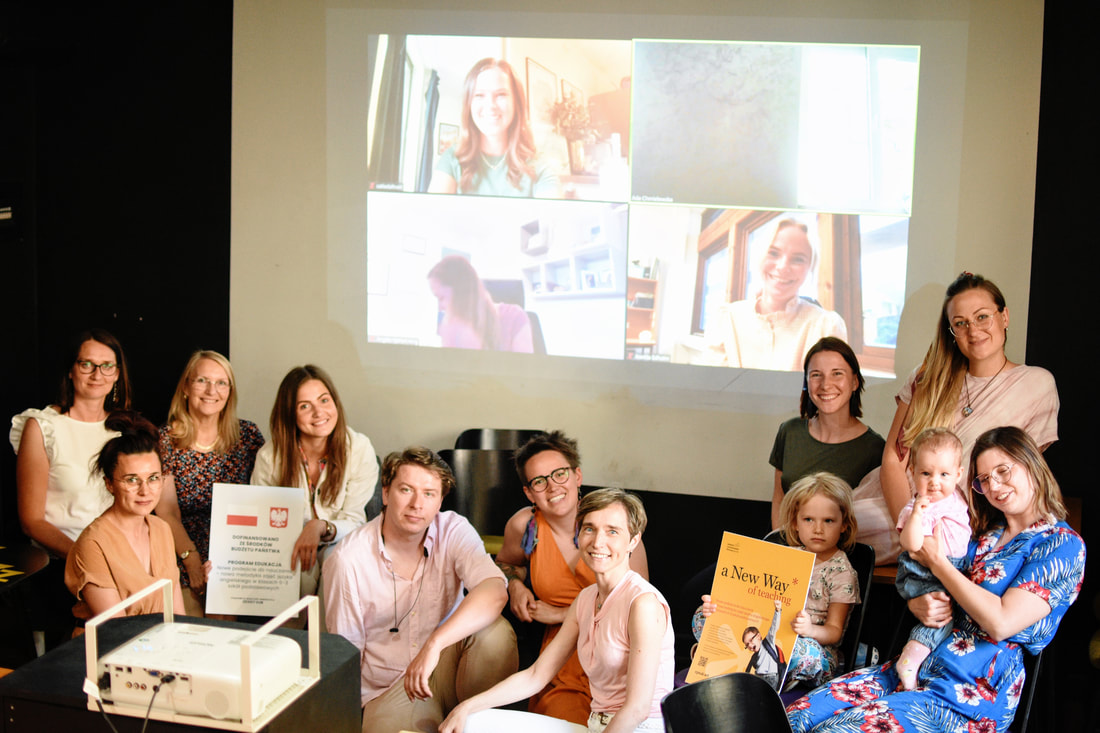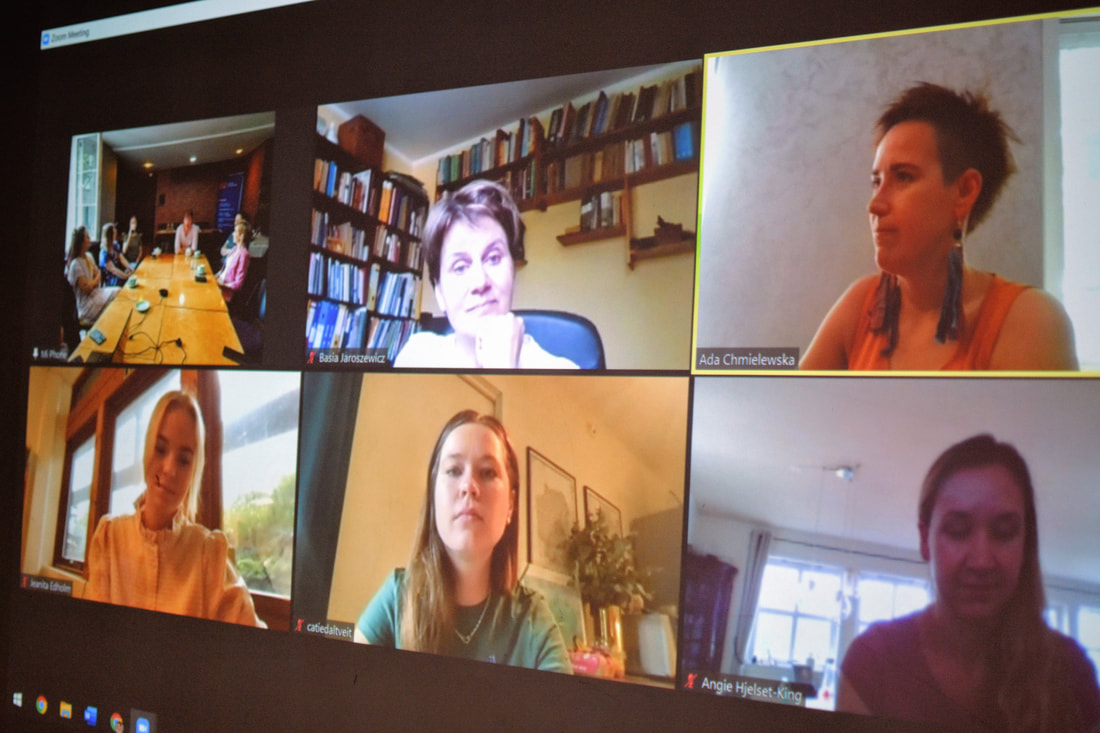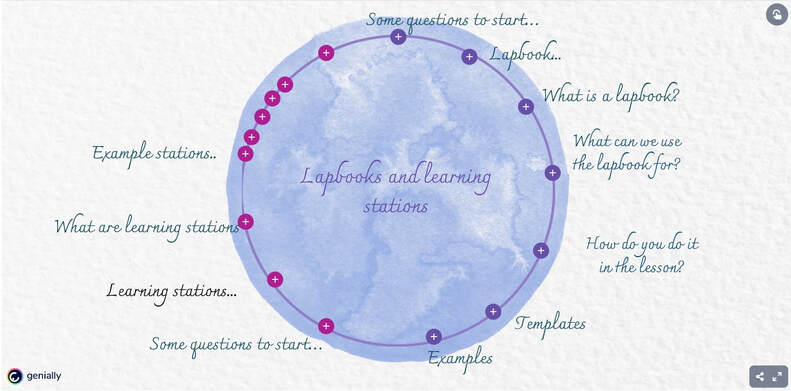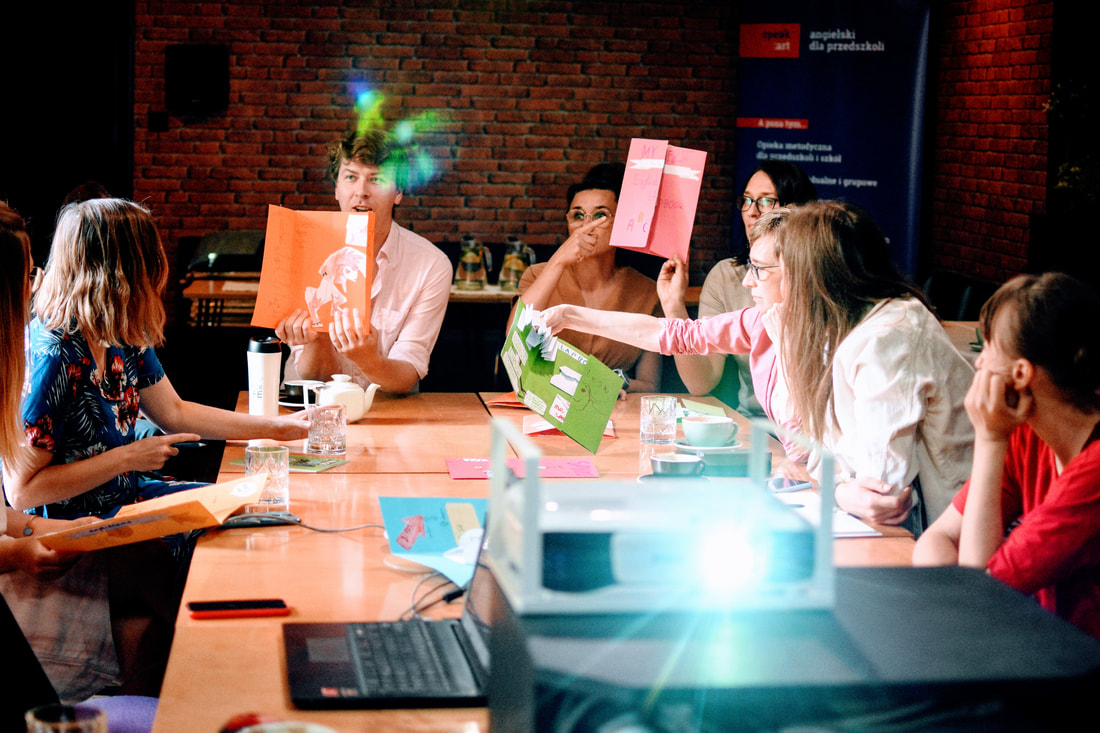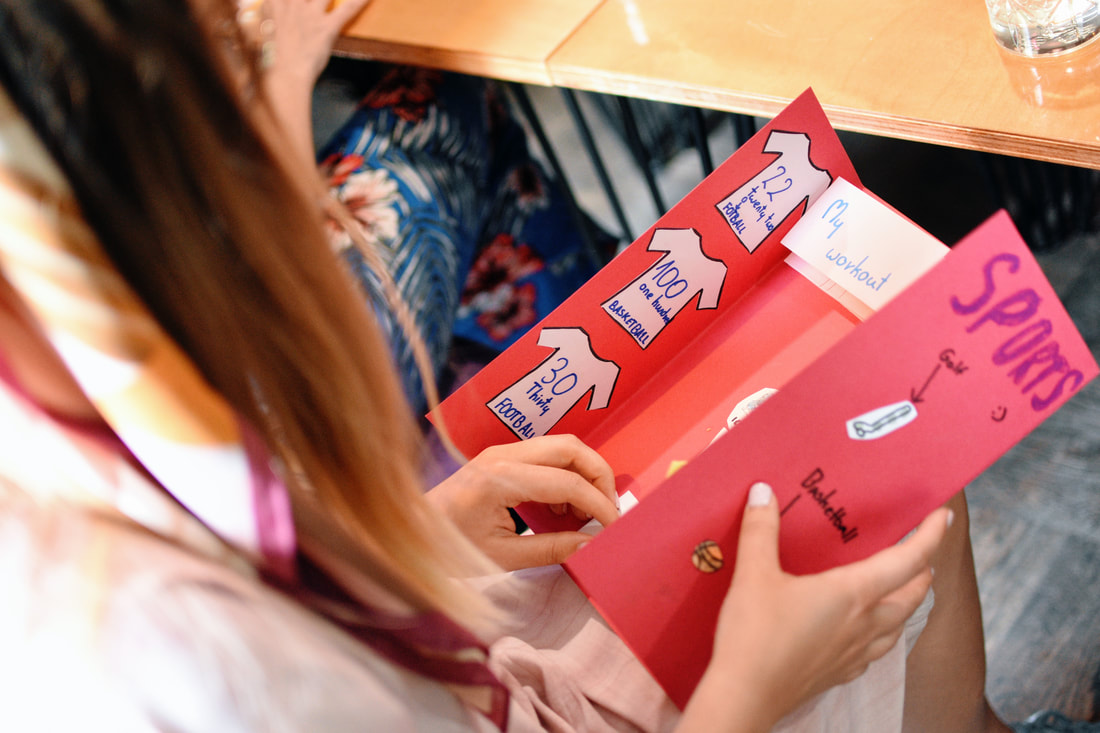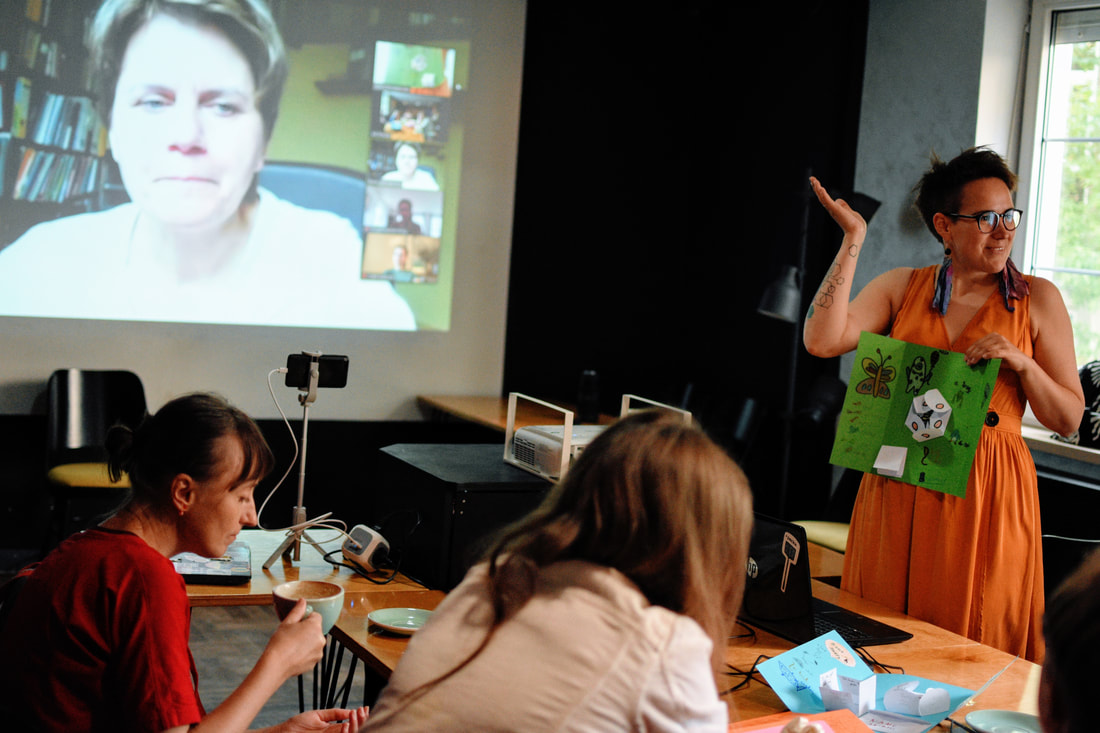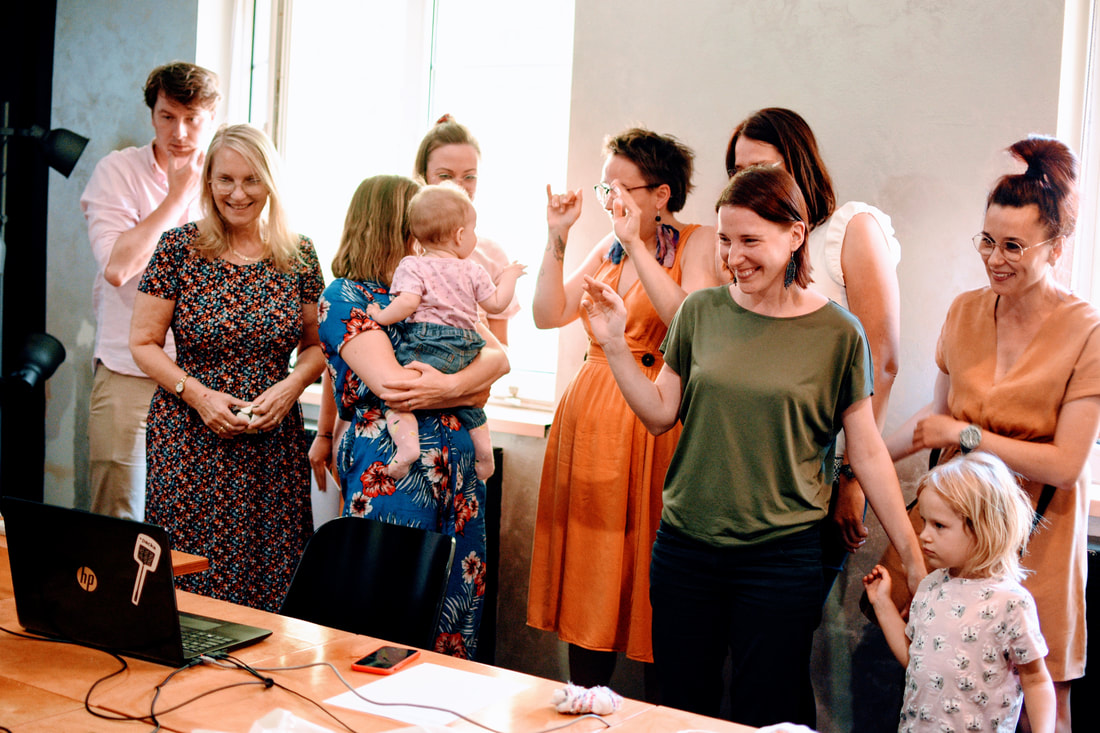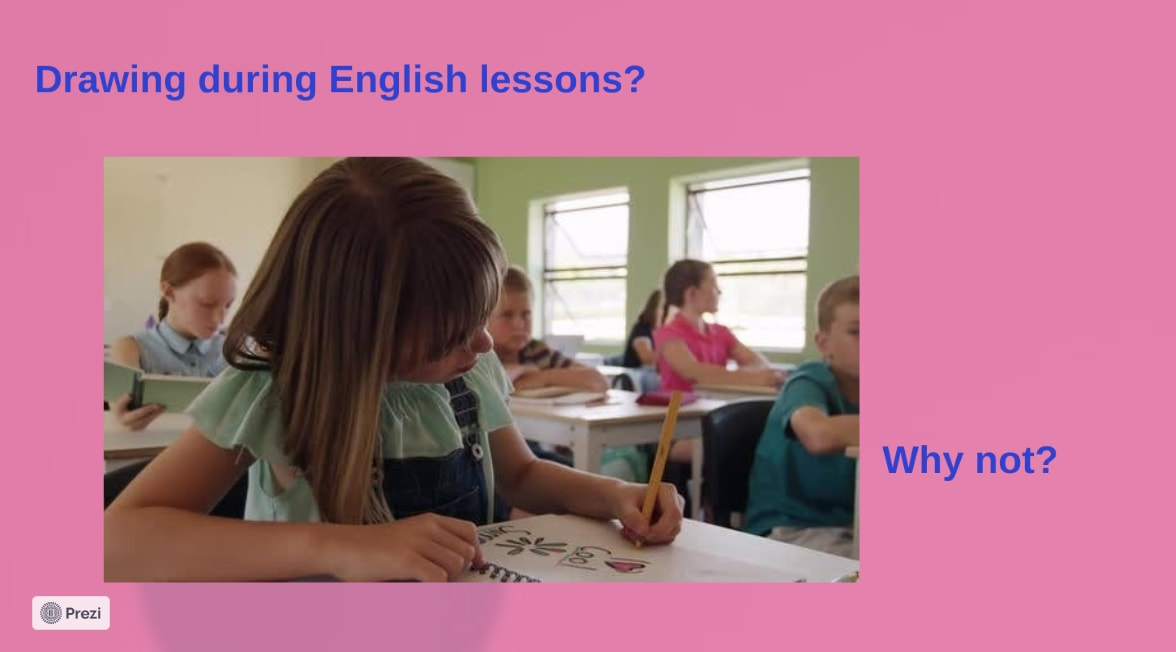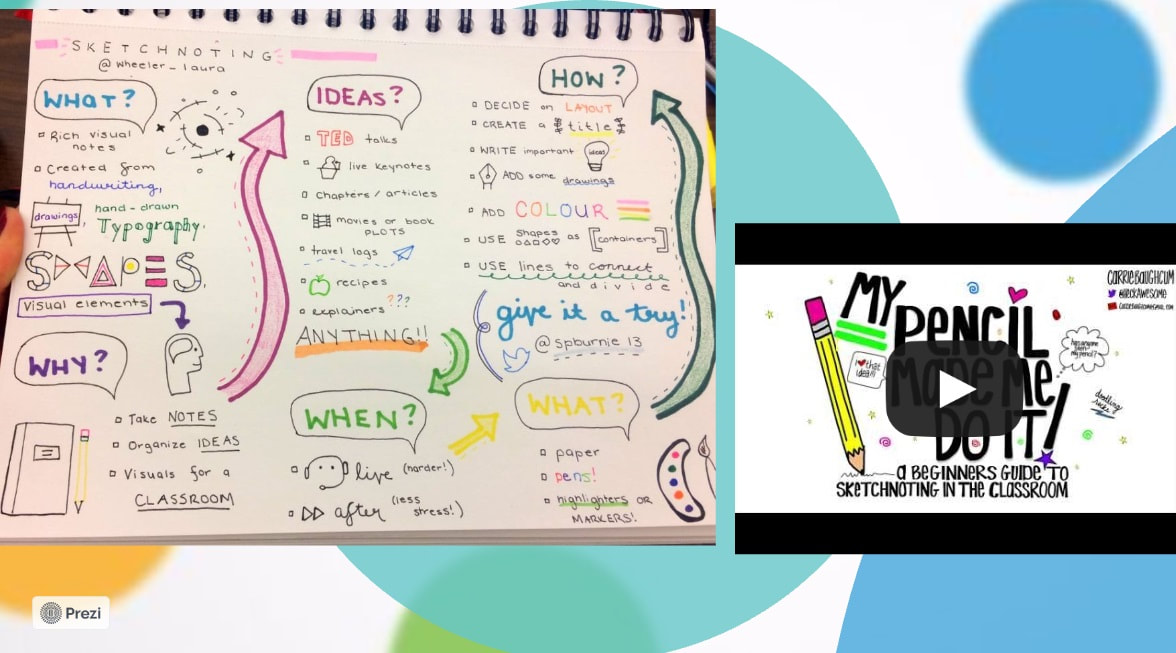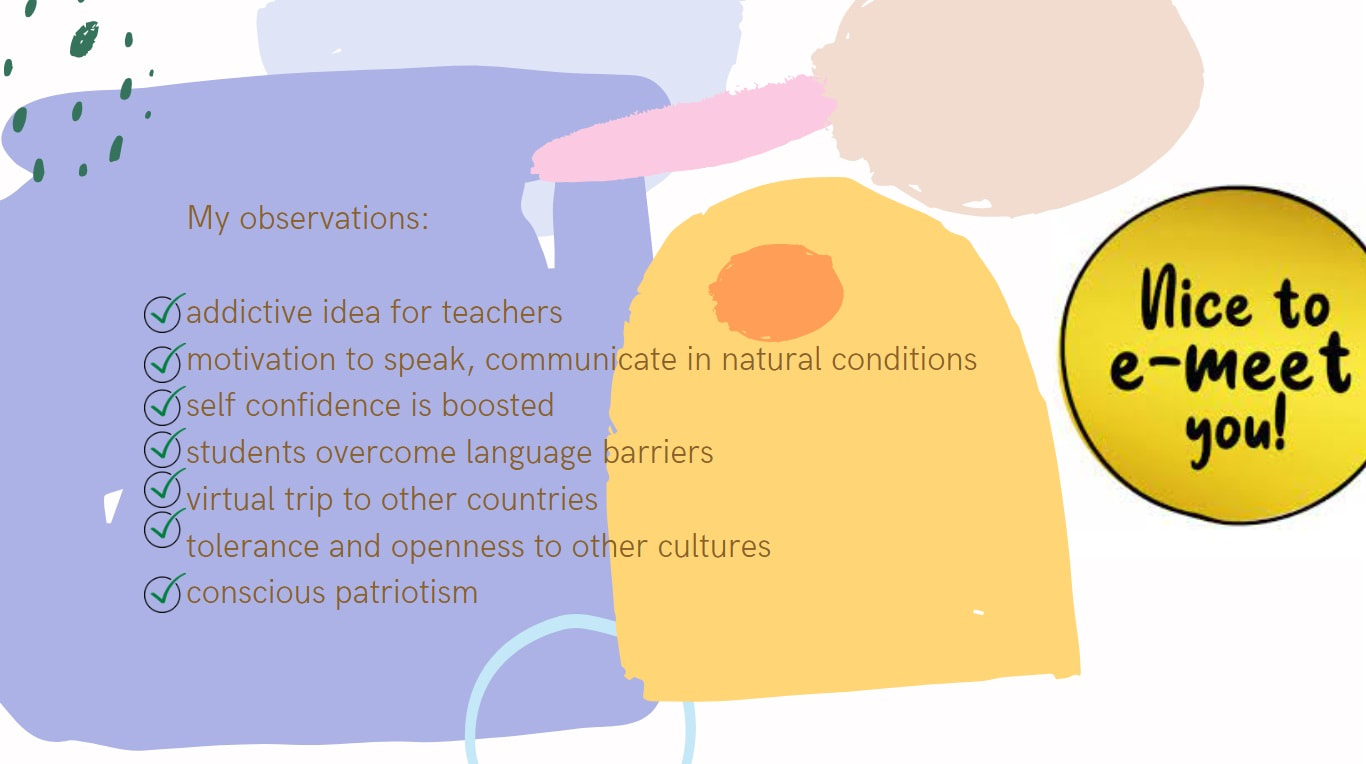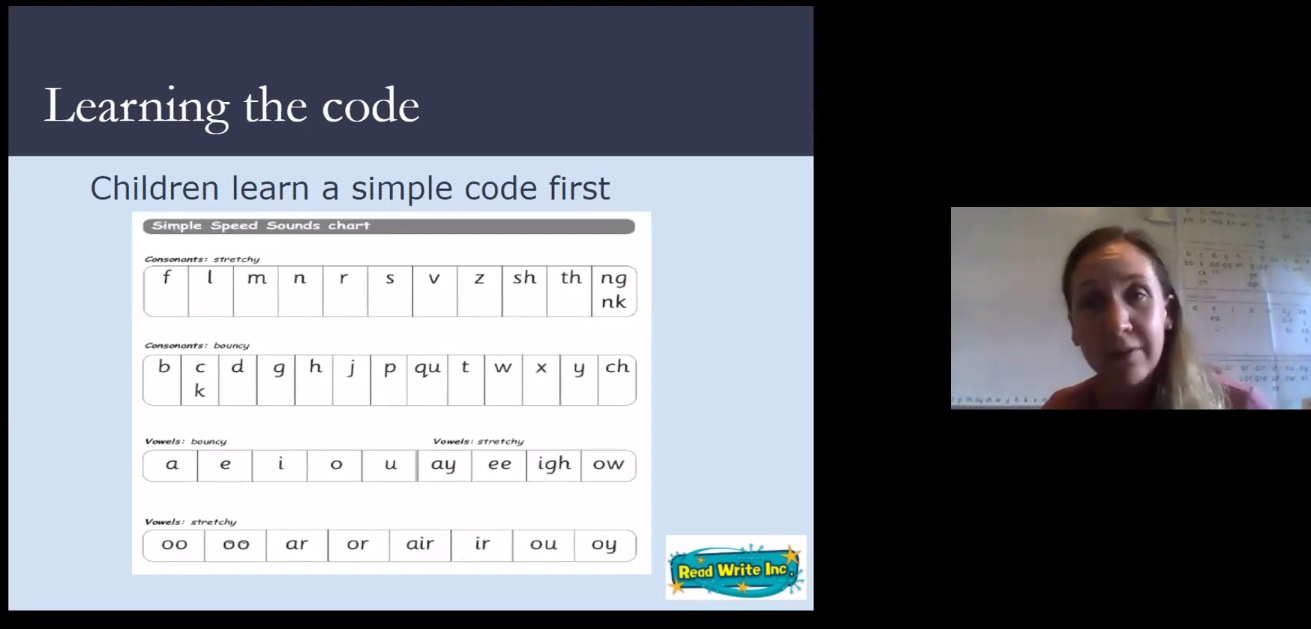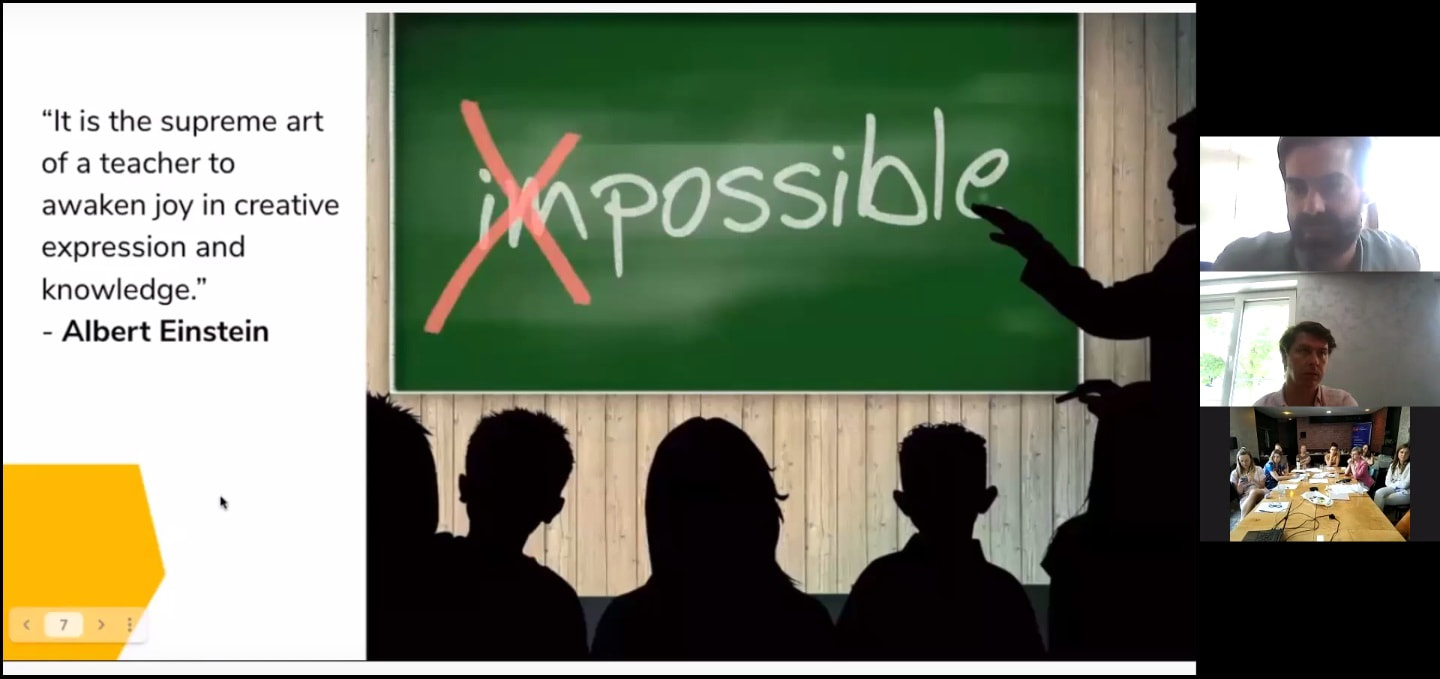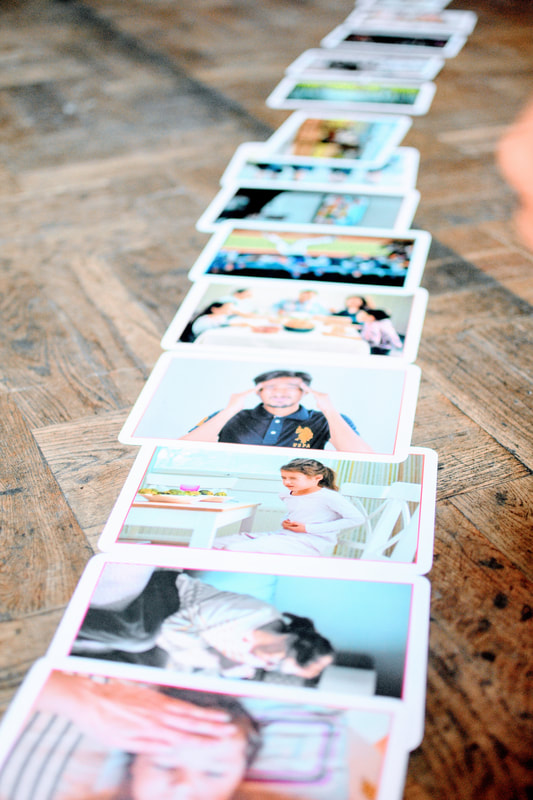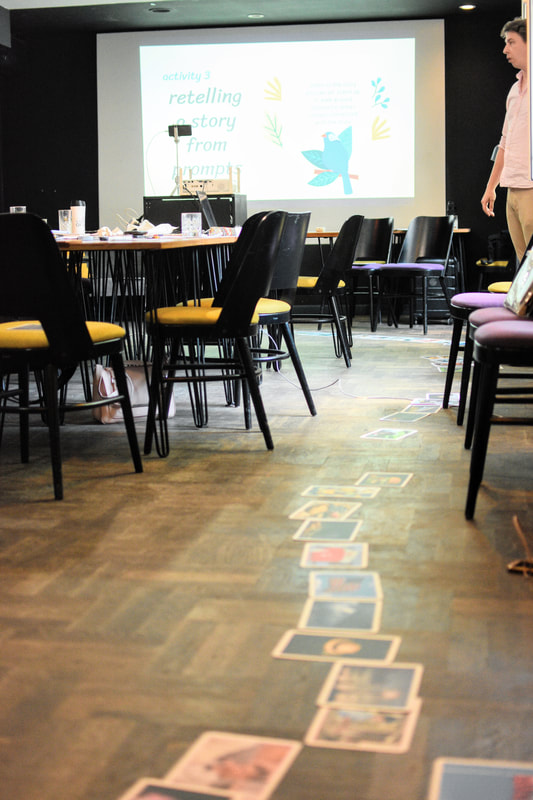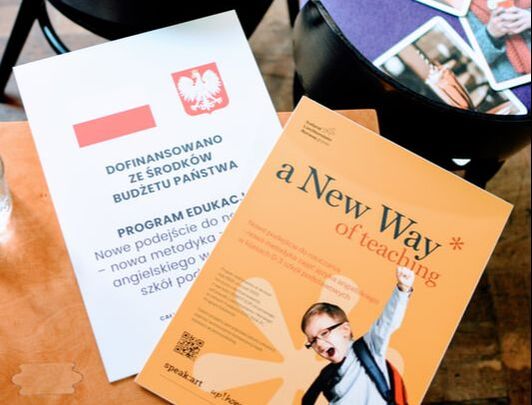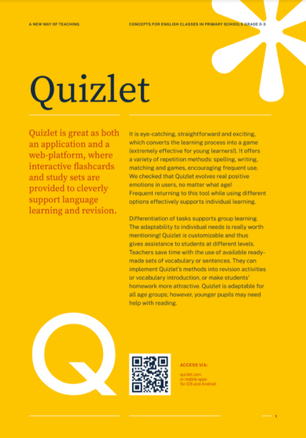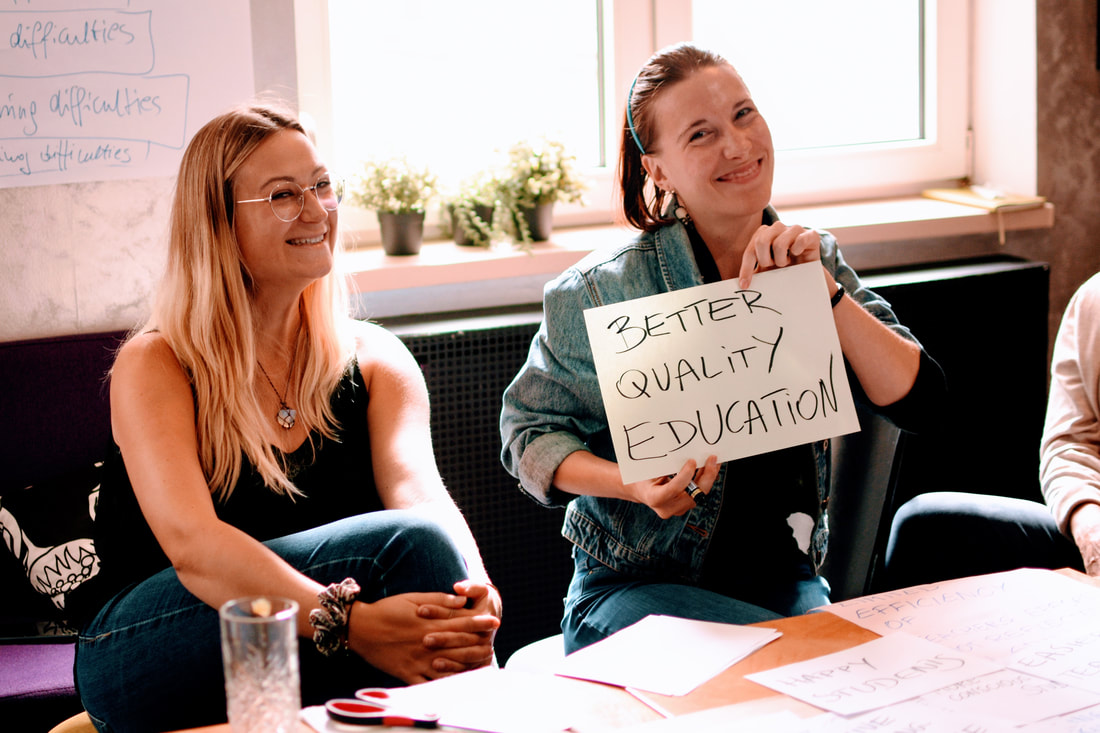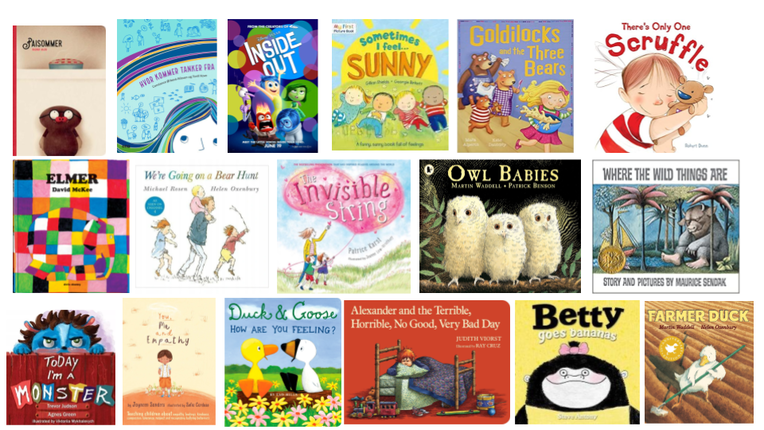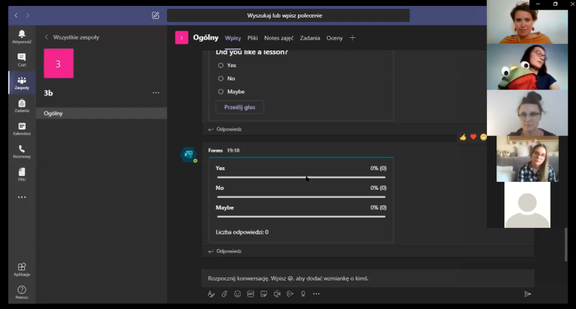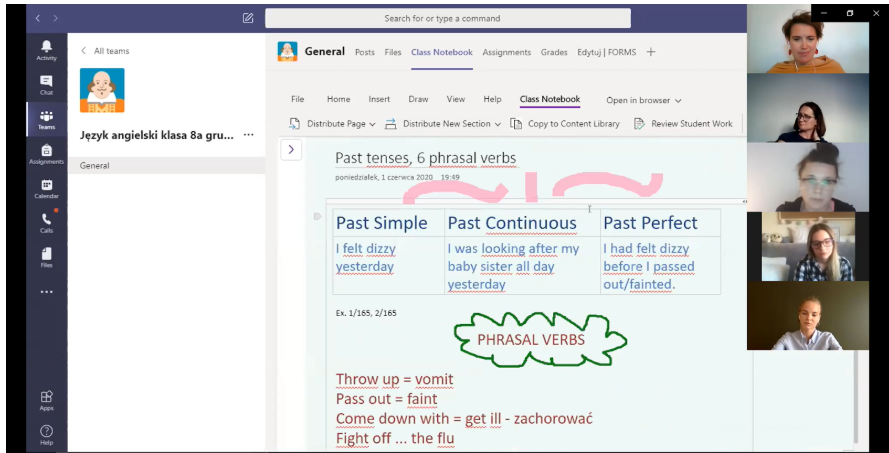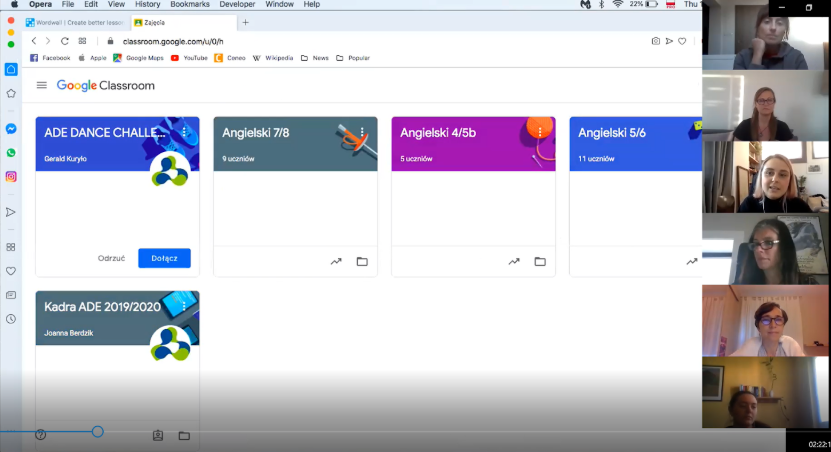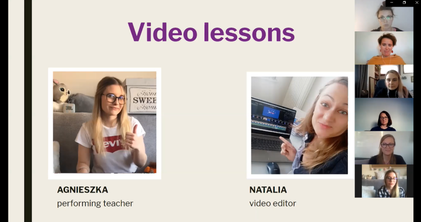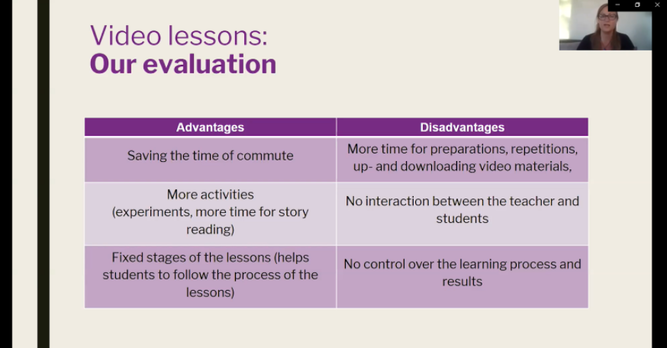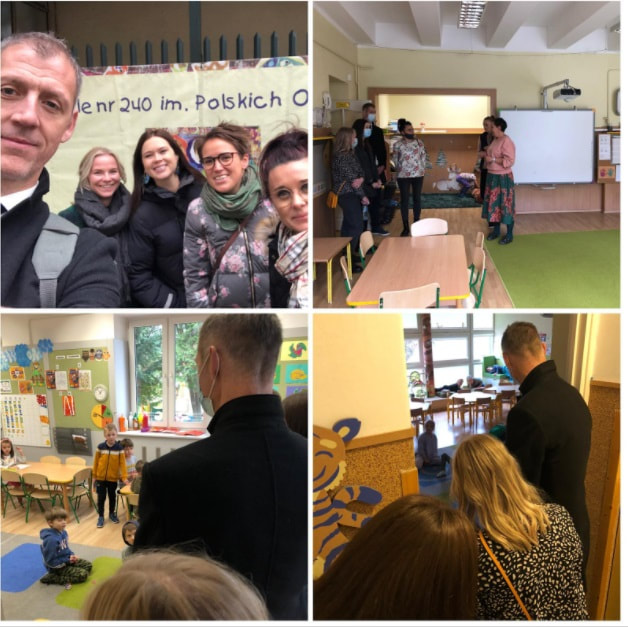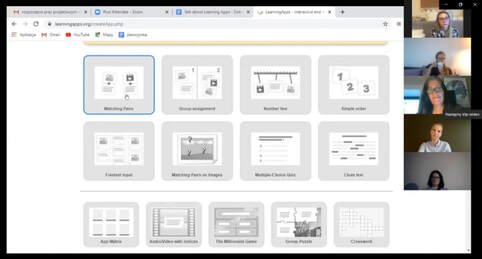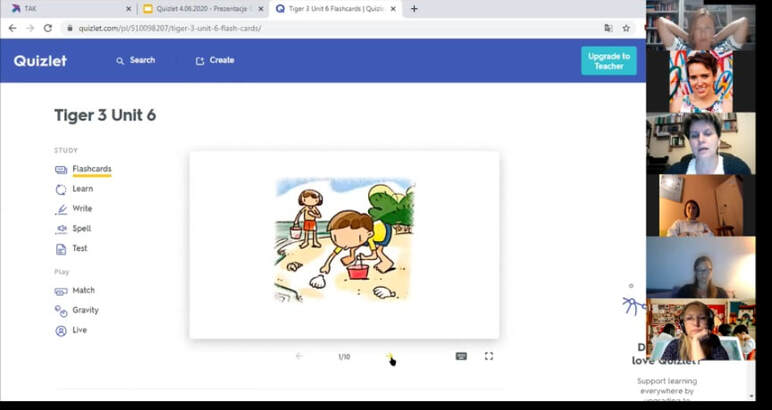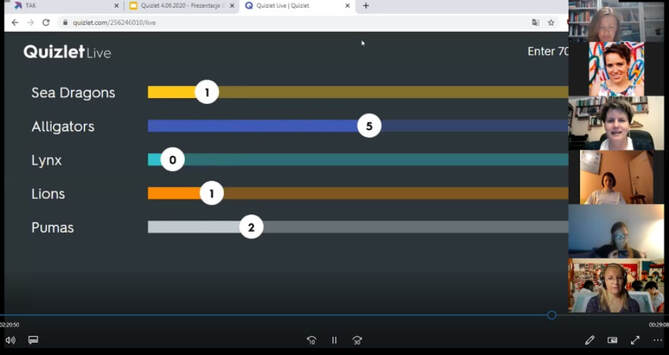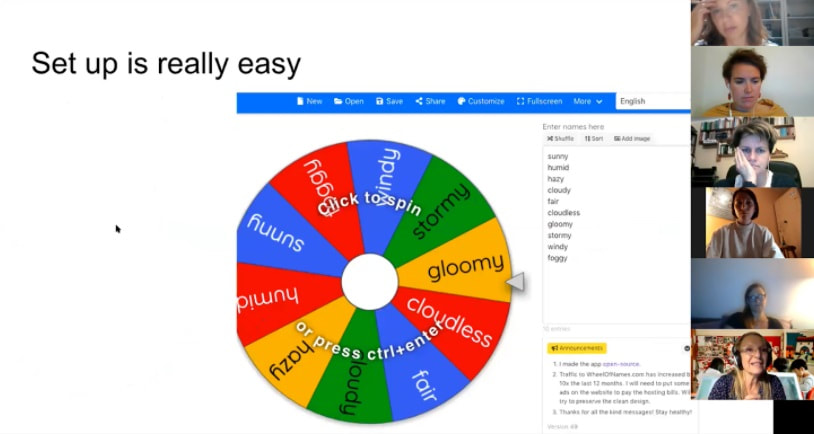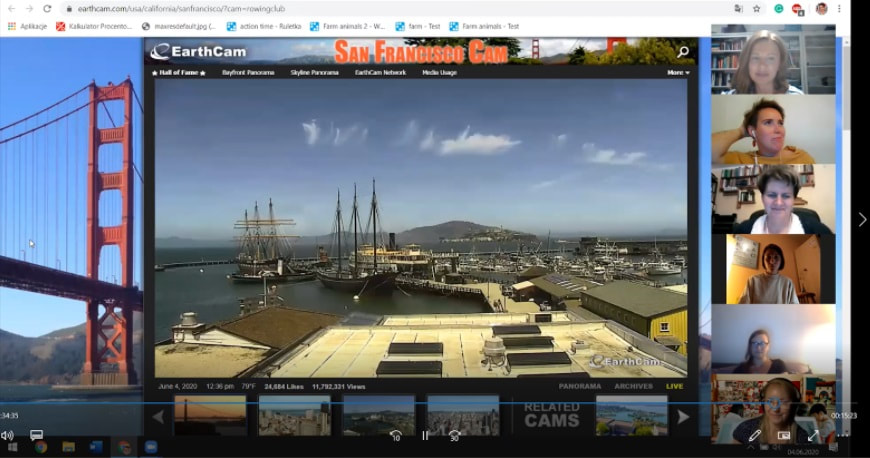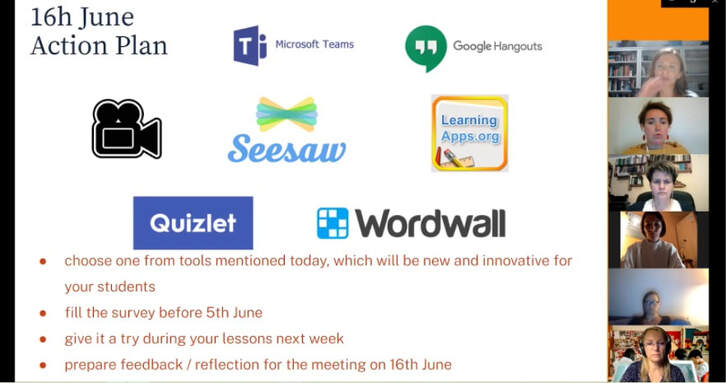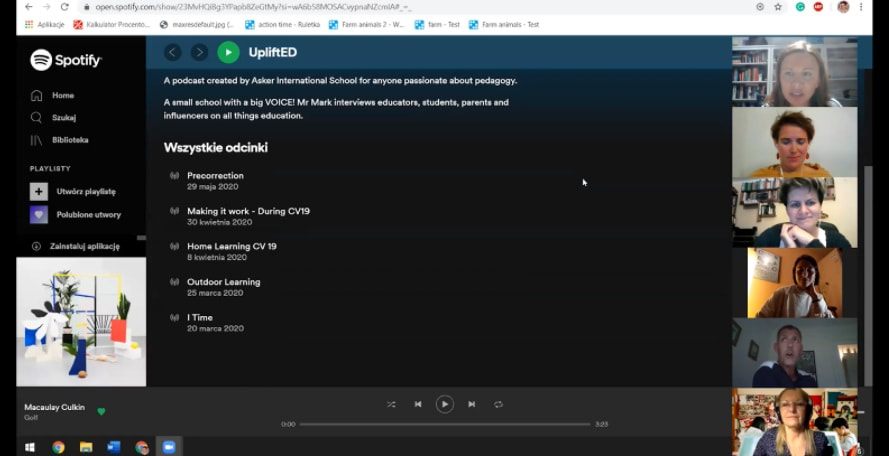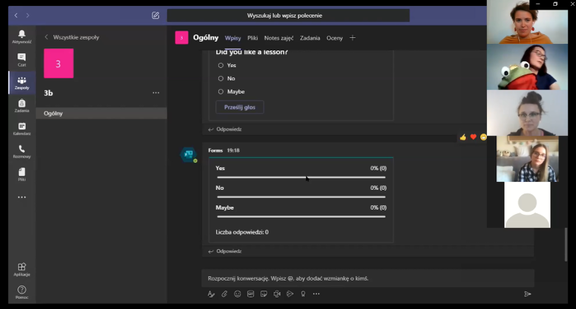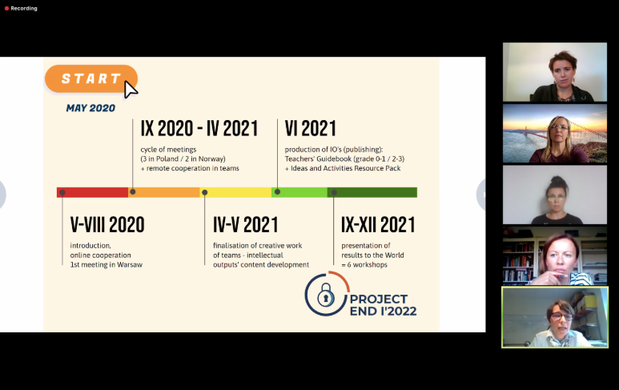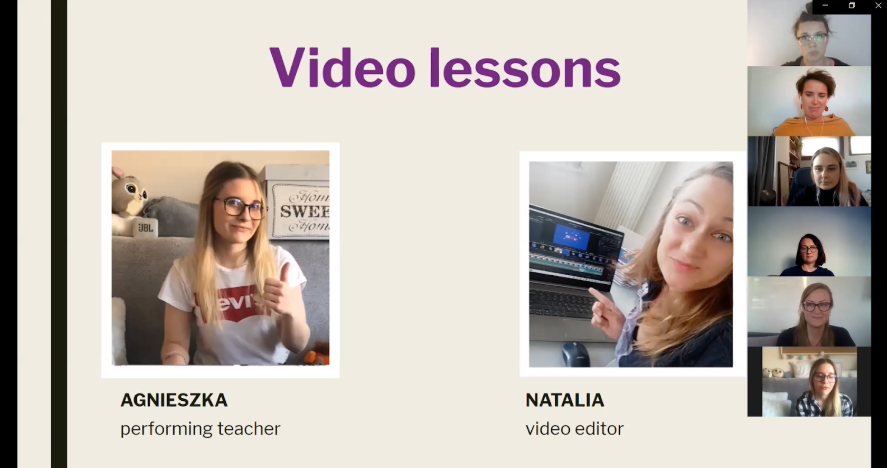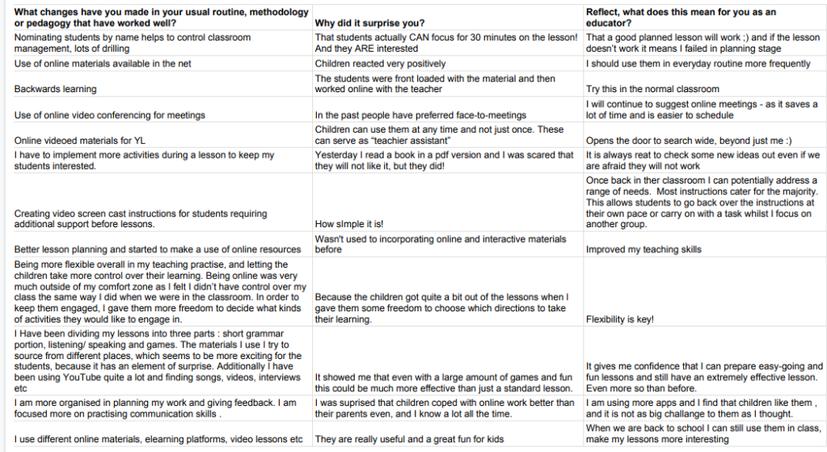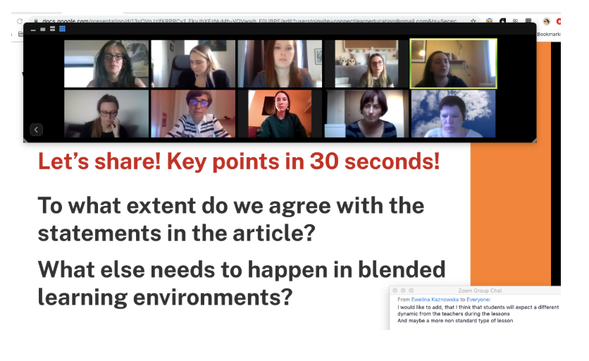25th of March 2022
Let's celebrate the results!

On Friday, 22nd of March, whole team of "A New Way of Teaching" met for the last time to celebrate the last moments of our protejct. Not only we had an amazing dinner but also we devoted some time to reflect on our last 2 years of the project experience. For many of us it was the first time participating in such a long-term event and we all agreed that it has been a great time full of team work, teaching inspirations, lesson observation, school visits and the most important intellectual outputs.
The most exciting moment took place once the participants received long-awaited project results:
You can download our Project Results here.
The most exciting moment took place once the participants received long-awaited project results:
- Teacher's Guidebook,
- Troubleshooter
- Idea Bank
You can download our Project Results here.
4th of November, 2021
Norwegians visit Poland for the 1st time!
|
Finally, after months of Covid restrictions, teachers from Asker International School could visit Poland. Their visit’s plan was very complex. We took a tour of our partner schools - Akademia Dobrej Edukacji in Jabłonna and Public School in Żuromin. We also got invited to observe lessons in Verne Non-Public Primary School in Warsaw and Public Kindergarten no. 240 nearby. We’re very grateful that they shared with us their teaching practices.
We took part in the full-day project meeting. This time we gathered and sorted the best ideas for grammar activities and planned further project work to finish our teacher’s guidebooks. We found out what areas need to be developed and further described and divided future work. At the very end of the meeting we all came to a conclusion that we can’t wait to see our Teacher’s Guidebooks as Intellectual Outputs of A New Way of Teaching* project. |
25th of October, 2021
Norway, here we are again!
by Natalia Nesteruk
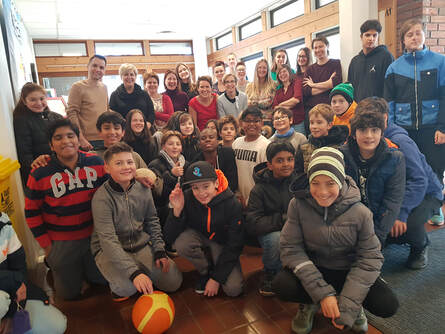
A month after the previous visit we met again in Norway to share our experiences of the implementations and enlarge current ideas. Participating teachers were asked to implement in September new teaching methods and tools discovered during previous meetings and observed at lessons in Asker International School. During the second visit we had a great chance to share reflections. At the workshop sessions we discussed the ways to apply success criteria for our students, gathered the best but universal and easy to prepare grammar activities and took part in the first edition of our original concept of “live library”. Live library was a session inspired by stations’ method and Living Wax Museum - a project performed by students in AIS - where participants visit different stations to meet teacher-experts.
On the second day we brainstormed innovative teaching ideas to solve well-known puzzles:
On the second day we brainstormed innovative teaching ideas to solve well-known puzzles:
- How to boost students' attention span?
- What mindful activities can we include in English lessons?
- How to implement project methods?
- What brain breaks and TPR activities can support our students’ needs?
We were also lucky to receive invitations to visit other schools in Norway thanks to our Norwegian partner. We visited and observed lessons in a public Norwegian school - Manglerud Skole and in International Montessori Preschool. Comparing different Norwegian schools, their English lessons and organisation aspects with Polish ones, our teachers got really reflective. It helped us to set up new teaching goals to implement innovation methods in daily practices. Check out our photos taken in the norwegian schools below.
|
|
20th of August, 2021
Long-Awaited Trip to Norway
by Natalia Nesteruk
Finally we had a chance to fly to Norway to visit our partner - Asker International School (AIS). In August, while students and teachers in Poland were still having their holidays, schools in Norway started the school year. Thus, this was a perfect time to go there and visit our Norwegian participants in their first moments of teaching. The schedule of our trip was neatly organised, the plan included two days of workshops and lessons’ observations in Asker International School and sightseeing activities in the meantime. In AIS some of our project participants prepared teaching workshops. Angela Hjelset-King presented her approach to English Phonics, Kasia Giedroyć talked about teacher’s assistants, a method which supports learner’s autonomy and Natalia Nesteruk engaged teachers in creating new vocabulary drilling ideas. What is more, Ada and Łukasz conducted A New Way of Teaching project sessions. The aim of these sessions was to plan forthcoming implementation of innovative teaching practices proposed in previous project meetings. During the second day of a visit all Polish teachers had an opportunity to observe AIS lessons conducted by teachers of various school subjects and see their teaching methods typical for school following PYP syllabus. If you want to discover photos from our trip scroll below :)
11th of June, 2021 - Hybrid meeting of A New Way* Project
by Beata Mirecka-Jakubowska
As the pandemic restrictions continue to apply, the meeting held on 11th of June 2021 was conducted in a hybrid fashion, with teachers logging in from Asker, Norway, and Opole, Poland, while a large group met face-to-face in Warsaw. Together, the teachers discussed several important elements of the project and shared their collective knowledge and experiences garnered thanks to the collaborative work completed thus far.
After a warm welcome and long-overdue meet and greet session as teachers saw each other in person for the first time, the first presentation was launched. Barbara Jaroszewicz, signing in from Opole’s TAK school, conducted a marvellous hands-on activity involving lapbooks and also presented the learning stations prepared by Dorota Czauderna-Pracka.
Teachers gathered in Warsaw were provided with specimens of student-made lapbooks to peruse and to choose one to examine more deeply, imagining the metacognition process that may have taken place while the student was constructing the artifact. The lapbooks contained a variety of topics and grammar structures to be learned, and it was clear that each student put much thought into the content and design. It became clear to everyone that lapbooks are a powerful hands-on learning experience, fun, engaging and highly educational, adaptable to most subjects and grade levels.
|
Learning stations allow students to work at their own pace and can be a way to differentiate the content for deep and thorough learning by all learners, fast and slow alike. The quick learners can move quickly through the stations and required tasks, while slower learners can take their time completing their work. Differentiation in the content and additional challenges for the “fast and furious” as extension of their learning allows all learners to make excellent progress within their own capacities. |
Katarzyna Szymańska continued the sharing by presenting three very useful websites:
https://www.senteacher.org/ where teachers can find resources like games, worksheets and flashcards for a number of subjects, including English and mathematics.
https://bingobaker.com/ where teachers can either make their own or find ready-made bingo templates that can also be customized to fit their needs. Thousands of topics, vocabulary sets and grammar points are already available.
https://avatarmaker.com/ where students and teachers alike can create their own avatars and use them as needed in their daily educational endeavors.
https://www.senteacher.org/ where teachers can find resources like games, worksheets and flashcards for a number of subjects, including English and mathematics.
https://bingobaker.com/ where teachers can either make their own or find ready-made bingo templates that can also be customized to fit their needs. Thousands of topics, vocabulary sets and grammar points are already available.
https://avatarmaker.com/ where students and teachers alike can create their own avatars and use them as needed in their daily educational endeavors.
Agata Woźniak shared her experiences during an exchange program she completed in Kenya with Kenyan, Ghanian, English and Polish teachers, also leading some of the workshops. The participants updated their knowledge of digital tools for learning, expressing ideas through theater and body language, and using various other communication methods. The project aimed to promote the inclusion of underprivileged students. Concluding her presentation, Agata praised the value of visuals in teaching and learning, including students doodling during the lessons, sparking a heated discussion on the merits and demerits of permitting students to doodle.
The use of sketchnoting was also discussed, with conclusions drawn that sketchnoting is a more advanced method of taking notes with drawings, but can be quite useful as an alternative to traditional note taking. Key ideas were to ensure there’s prioritization towards key ideas and learning outcomes rather than simply drawing or focusing on perfection in the drawing process.
The use of sketchnoting was also discussed, with conclusions drawn that sketchnoting is a more advanced method of taking notes with drawings, but can be quite useful as an alternative to traditional note taking. Key ideas were to ensure there’s prioritization towards key ideas and learning outcomes rather than simply drawing or focusing on perfection in the drawing process.
|
Magda Wieczorkowska and Kasia Lachowicz presented their learning and ideas garnered thanks to A New Way Project. They involved the participants in a guessing game and reviewed not only the current contributions by the participants but also shared their ways of implementing these resources in their teaching. Great fun was had by all as the participants’ repertoire of tool implementation was broadened even further. Key ideas included teaching the students how to perform a self-reflection and self-evaluation of their learning, and discussion on the benefits of such an assessment of students’ own progress
|
|
The highlight of the presentation was the intercultural exchange with Malaysian, Vietnamese, and Georgian students. Polish students were excited to prepare presentations and share their culture online with the students from other countries. A whole list of benefits of such teamwork was discussed and encouraged, especially in the era of online or hybrid learning imposed by the pandemic restrictions.
|
|
After a break, participants listened to Angela Hjelset-King’s talk on using a synthetic phonics program Read Write Inc! As reading is the biggest indicator of social change, it is crucial for students to not only learn to read but also become lifelong readers and confident, creative writers.
|
Angela explained the five major principles of the Read Write Inc! Program:
The program is excellent for beginner readers, English language learners, children with learning difficulties and older children who need to catch up on their reading abilities. Read Write Inc! is data-based and well researched for effectiveness, inclusive, systematic and structured, and most of all, provides immediate and visible results in the very first tries. |
|
Next was Andrew Johns, the head of the primary school at Asker, who presented the idea of PROVOCATION and provoked all participants to provoke their students in turn.
Starting from a BLANK CANVAS the participants were asked to recall the features of their favorite lesson; a variety of memorable learning experiences were shared. What actually remains memorable is the unexpected, the unprepared, the funny or strange, the shocking or provoking deep thinking and learning. Provoking in a positive way to expand one’s horizons, deepen one’s knowledge, and broaden one’s view is a very powerful tool to weave into the lessons in order to develop greater creativity and higher order thinking skills. |
Lastly, teachers participated in a hands-on workshop on storytelling, led by Łukasz Knapp. The photos tell it all! It was a fun, engaging activity and certainly enhanced everyone’s HOTS.
All in all the hybrid meeting of the Norwegian and Polish teachers was a great success. Participants left with a plethora of practical tips and activities to implement in their lessons from next Monday!
A new hope for A New Way* actions after winter remote work
by Iga Smulska
Due to the prolonged disruptions caused by the coronavirus, between November 2020 and April 2021, the activities of our project team were limited to online meetings and asynchronous work in task groups as well as participants continuing their individual work towards creating our Intellectual Outputs. This way, we continued the multilateral cooperation of teachers and educators from the partner institutions. Participants took part in several workshops, interesting discussions with experts and exchanged experiences, which contributed to further developing their competences as early-school education staff.
Thanks to mutual inspiration, teachers used a wider range of tools and methods in their everyday work with students and tested the impact of strengthening relationships with students' parents on improving the didactic outcomes. Our team’s benefit was confirmed both in discussions during our online meetings as well as in the results of a survey conducted among the project participants at the end of April.
Yes, we had to adapt our cooperation methods to the ongoing travel restrictions caused by the COVID-19 pandemic. While we still haven't been able to see each other in real life, the entire team met online four times during the winter-spring period. In addition to that, the four international task groups into which our team was divided collaborated remotely, holding a total of 23 online meetings over the course of six months.
We are proud to say that despite the unfavourable circumstances, we are getting closer to achieving the goal of our project! We would like to thank all participants for their ongoing commitment! We look forward to seeing you face-to-face soon!
Thanks to mutual inspiration, teachers used a wider range of tools and methods in their everyday work with students and tested the impact of strengthening relationships with students' parents on improving the didactic outcomes. Our team’s benefit was confirmed both in discussions during our online meetings as well as in the results of a survey conducted among the project participants at the end of April.
Yes, we had to adapt our cooperation methods to the ongoing travel restrictions caused by the COVID-19 pandemic. While we still haven't been able to see each other in real life, the entire team met online four times during the winter-spring period. In addition to that, the four international task groups into which our team was divided collaborated remotely, holding a total of 23 online meetings over the course of six months.
We are proud to say that despite the unfavourable circumstances, we are getting closer to achieving the goal of our project! We would like to thank all participants for their ongoing commitment! We look forward to seeing you face-to-face soon!
Our favourite online tools for remote teaching
|
We have the first colourful results of our project work!
Quizlet, Wordwall, video recording, Edpuzzle, Epic...These are our favourite tools for online teaching. You can read more about them in the PDF file below. Check this out!
| ||||||
Group work in A New Way* in autumn
|
On October 20th Group 1 presented their findings on how to influence students' motivation and help them attain a positive attitude towards learning. Among other things, we were presented with the results of an experimental joint online lesson of a class from the Żuromin school and a group of students from Asker. We could observe the natural enthusiasm of young learners filmed by the two teachers. Moreover, recommendations were made regarding some smart books for children, supporting discussions about emotions. A photo attached to this report shows the proposals of our team members made in regards to the colorful literature that was helpful in working with the youngest students when talking about emotions and feelings.
Group 2 discussed the topic of students' mental burden which causes educational blockages. They provided the team with some ideas on how to accept mistakes as part of the learning process. Also they shared a variety of options supporting students in developing higher order thinking skills. In addition, we were provided examples of invaluable and countless possibilities of the use of VISUALS in class. This topic has had a continuation in a survey - conducted after the meeting, where participants shared THE BEST EXAMPLES of using visuals (graphics, infographics, photos, pictures, etc.) in their teaching. The summary of this survey can be viewed in the file below:
| using_visuals_in_english_lessons.pdf |
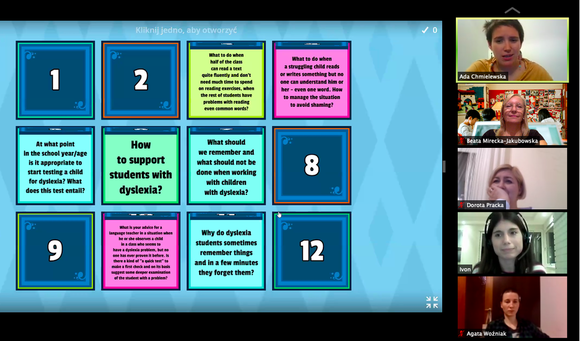
At the meeting on November 5th, we decided to divide our team into two groups so that each project participant would have a better chance to share their opinions and take an active part in discussions. Group 3 presented their findings to the members of Group 2 on the topic of dealing with limited learning abilities and poor language skills. Group 4 discussed with Group 1 the topic of parents, their support, and their relationship with teachers.
At the end of the second meeting, we had a special surprise for our participants. Ivon, an expert on working with dyslexic students from Asker International School, joined our meeting and shared her experience with us. She also answered a number of questions that had been raised by participants. Thanks to her presentation, our team gained some new, amazing ideas on how to recognize the problem of dyslexia and how to work with dyslexic children.
At the end of the second meeting, we had a special surprise for our participants. Ivon, an expert on working with dyslexic students from Asker International School, joined our meeting and shared her experience with us. She also answered a number of questions that had been raised by participants. Thanks to her presentation, our team gained some new, amazing ideas on how to recognize the problem of dyslexia and how to work with dyslexic children.
Ahead of us is the continuation of asynchronous work in groups. In December we will meet to discuss our experiences in testing the tools described by our colleagues and the results of new ways of teaching implemented in our lessons.
A New Way* First Hybrid Meeting
by Ada Chmielewska
|
Two of the last beautiful days of the summer 2020, 10-11th September (Thursday and Friday) were very intensive for the participants of our project A New Way of Teaching. Finally we have met! It was our first face to face meeting so we had a chance to get to know each other a little bit more than just only though Zoom.
Due to the current regulations some of the participants located abroad couldn't have joined us for the meeting in Warsaw, but thanks to the new technology they were able to participate remotely. Together with the partner from Asker International School and Beata Mirecka-Jakubowska who is currently in her second home in Indonesia, we had decided to change the form of cooperation for hybrid face 2 face & online. All participants from Polish schools met in Warsaw, but teachers from Norway and Beata, who was this time back in Jakarta, joined us via Zoom to continue the project work . |
|
This type of a meeting was something new and challenging for all of us, but thanks to full commitment of our team, it turned out to be fully successful. We have used an overhead projector to see participants abroad and a laptop and a smartphone on a tripod to transmit them the current situation in the project room in Warsaw. To facilitate oral conversation between teams we have used a conference speaker. Overall the organisation was satisfying and we managed to foresaw all possible technological difficulties.
We would like to thank all teachers who came to Warsaw from:
We would like to thank all teachers who came to Warsaw from:
- Akademia Dobrej Edukacji – Jabłonna
- Szkoła Podstawowa TAK im. Ireny Sendlerowej
- Primary School at Conrada Street
- Żeromski Primary School in Żuromin
- representatives of up!homo.
- Asker International School from Norway
- Beata Mirecka-Jakubowska from Indonesia!
A New Way* Team meets online again
by Natalia Nesteruk
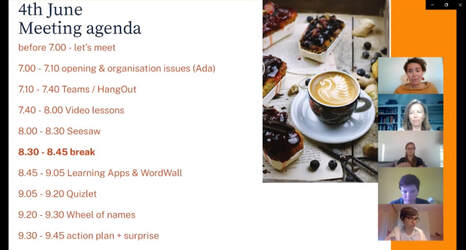
And here we meet again. This time all participants prepared short presentations on various teaching tools that they have been using during online teaching. Thus, our agenda was very tight.
- Microsoft Teams/HangOut and Google Classroom
|
Magda, the second teacher from Żeromski Primary School, shared her experience with Microsoft Teams and highlighted its advantages → it supports collaboration between students and develops and facilitates communication between students and teachers. In this part we discovered various options which help teachers to plan and conduct the lessons. When planning a lesson, teachers can prepare a full document with a topic of the lesson, pictures, explanations, as well as links to other websites and resources. Also s/he can draw a picture or underline important information. The same document can be shared with various groups a teacher has.
|
|
Ewelina from Academy of Good Education also presented her way of using Google Classroom. According to her, the platform is very neat, intuitive, and easy to use. A great thing is that the teacher can set up the homework for the whole group or she can choose specific students. It is a great advantage when it comes to differentiation of our teaching. Moreover, Ewelina presented the Google Calendar where she can easily schedule the meeting and invite her students quickly.
Following these three presentations we had a quick discussion on platforms presented, their advantages and disadvantages. We also compared these platforms to Zoom. We arrived at the conclusion that an amazing strength of Google Classroom is absence of time or participant limits when it comes to online conferences. |
|
2. Video Lessons
During the next presentation we discovered how Agnieszka and Natalia produce video lessons which are an alternative for online lessons. They have already created 26 lessons. The ladies showed us the fixed structure of each lesson, which helps students be aware of the stages of the lesson. Moreover, thanks to these clear stages of the lesson students feel safe and can easily follow the lesson. Agnieszka presented various activities that she does during a lesson: songs, books and posters, games, experiments, sorting activities based on the CLIL method, and choral reading. In order to engage students in these lessons, Agnieszka tries to plan the activities which engage students, such as bringing various things to the screen “lesson”, checking the weather, making decisions, or pointing various things at the screen. The ladies summed up their video lessons with advantages and disadvantages presented in the picture below. |
After this presentation we had time to think how we could use or include recordings during our lessons.
- Mya suggested using screen-o-matic for parts of a lesson and for formative feedback.
- Beata recorded her keynote speech for a conference and did a video podcast with 3 people and high school students to record presentations or parts of them to present while also presenting live in the class.
- Iga suggested asking students to record something and then share it with classmates.
- Basia videoed herself telling riddles to her students during lockdown and then they video recorded theirs and sent them back to her. Basia’s students loved watching one another's videos.
- Magdalena asked her students to record themselves when they were practicing reading.
|
3. Seesaw
The next presentation was prepared by teachers from Asker International School -- Catie, Sarah and Jeanita -- who shared their experience with Seesaw. Seesaw is a platform for online portfolios, where students can share what is happening with their learning with parents and teachers. Sarah showed how she and her first graders work with Seesaw. Thanks to the platform she could keep the routines (Morning circle, checking the weather) from the classroom during the lockdown and online lessons. She also admitted that it is mainly the teacher who is responsible for posting the newsletters on students’ learning on the platform. However, due to COVID-19, the use of Seesaw was more frequent, so students honed their skills of using it. |
Jeanita, who is a Norwegian teacher, shared her experience of Seesaw and agreed that it can support student learning and communication between students, parents and teachers. Jeanita showed us her student who was recording his reading and then posting it on his portfolio.
Catie explained how Seesaw helps her with differentiation. Students can choose the way of sharing their learning results - Seesaw allows submission of reports, videos, PowerPoint presentations, drawings, etc. Assignments with the same objectives can be modified when assigned to different students.
|
4. LearningApps and Wordwall
Kasia was the next teacher who showed us how to use the website www.learningapps.org. This website allows teachers to prepare various activities for students to practice the new knowledge. Activities such as matching pairs, group assignments, putting in order, quizzes, tests and many many others can be chosen from the bank of resources, or can be created by teachers. During home learning teachers can use learning apps to assign homework to students. Another website similar to “learning apps” that we discovered was WordWall.com which also allows students to practice new knowledge in a fun way via various online activities. |
5. Quizlet
Basia and Agata presented the website www.quizlet.com. Firstly, Basia showed how to use Quizlet, which, according to her colleagues, is one of the most popular tools to assist students’ learning especially when it comes to language learning. It is easy to use for teachers and students. It has many options. Students can choose various forms of activities based on skills they want to practice; thus, it supports developing skills such as listening, writing, spelling, reading.
Basia and Agata presented the website www.quizlet.com. Firstly, Basia showed how to use Quizlet, which, according to her colleagues, is one of the most popular tools to assist students’ learning especially when it comes to language learning. It is easy to use for teachers and students. It has many options. Students can choose various forms of activities based on skills they want to practice; thus, it supports developing skills such as listening, writing, spelling, reading.
At the end of this presentation we all had a chance to check out this website and play a group game about famous places around the world :)
|
6. Wheel of fortune
Beata presented a tool that she uses often with her students - the wheel of fortune. It can be used in different ways. We can use it to choose a student, to practice new vocabulary (a student has to use a new word in a sentence or a question) or we can ask students to answer different questions. It can really engage students in a conversation and it helps to create an interaction between students during an online lesson. 7. Earth Cams The last tool, presented by Ada, was a website earthcam.com which she uses to talk about different places around the world and describe the weather. At the end of this meeting we saw the Action Plan for the following days. |
At the very end, Mark, headteacher from Asker International School, talked about the podcasts from his school which became a new way of sharing the message to anyone who is passionate about pedagogy. Through the podcast teachers have a chance to shine and share their philosophy on different topics connected to education. They promote what they stand for and share ideas with the community. Every podcast has a different message from a different teacher, so we encourage all to listen to them. You can listen to the podcasts here, on Spotify here and on iTunes here.
A New Way* of Teaching reaches for success
By Beata Mirecka-Jakubowska
As exciting and anticipated as Elon Musk’s Falcon flight (at least to the participants of the “New Way* of teaching” project ) was the launch of the long-awaited collaboration of educators from Norway and Poland. Hooray! Success on both counts!
The “New Way* of Teaching” project aims to increase the quality of education by strengthening competencies of education staff through sharing experiences and knowledge. This is precisely what we began with on May 27 and May 28 when we met online in a ZOOM meeting room.
The “New Way* of Teaching” project aims to increase the quality of education by strengthening competencies of education staff through sharing experiences and knowledge. This is precisely what we began with on May 27 and May 28 when we met online in a ZOOM meeting room.
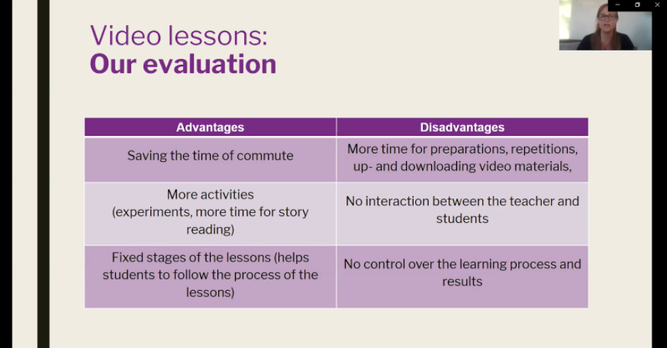
Day 1, May 27, 2020
First up was Iga Smulska, Project Coordinator, who warmly welcomed the participants and outlined the scope of the project. Iga briefly spoke about the needs for change, especially in light of the COVID-19 pandemic which drastically altered the delivery methods of traditional education, unaccustomed to the online setting. She also mentioned how the current situation has uncovered the shortcomings of teacher-centered methods of content delivery and the lack of adequate collaboration between teachers. With the cooperation of the participants from five schools, the project aims to bridge this collaboration gap and produce high quality intellectual output that will ignite further changes in the education community.
Iga discussed the proposed timeline of the two-year endeavor, presenting more details about each section of the timeline. Current travel restrictions imposed by the COVID-19 pandemic force alterations to the initial plans; however, mutually agreed dates and scope of remote and face-to-face collaboration will be subject to adjustment whenever restrictions are lifted in the future.
The first part of the webinar meeting on May 27th, 2020 was led by Ada Chmielewska, Project Coordinator, who first introduced herself and her Speak:art team members. Ada familiarized the participants with her vast experience in early child education, especially the move from face-to-face to purely online lessons. Much was said about the sudden need for adaptation forced by the pandemic and closure of schools and kindergartens, and how Ada’s team coped with the challenges to deliver as engaging and educational experiences to the young learners as it was humanly possible under the circumstances. Ada’s explanation of the new pyramid of priorities generated by the COVID-19 pandemic was enlightening: relationships with students and parents and relationships between students needed to be prioritized over the tools and teaching methods.
Ada’s introduction to the balanced online lesson for young learners was also superb. She explained the need to manage three areas in an equilibrium: personal interactions, developmentally appropriate content, and hands-on activities.
|
The second part of the webinar meeting on May 27th, 2020 was led by Beata Mirecka-Jakubowska, Educational Adviser to the project. Beata introduced herself and her teaching experiences spanning over three decades and outlined her IT journey from a school computer that took up the whole room back in the 1970's through learning on Apple II E’s, Mackintoshes, Dells and Apple laptops. Beata also mentioned various online tools she has been using over the past two decades in her own classrooms.
Subsequent to the introduction, Beata launched a sharing session which involved the participants in an exchange of thoughts on the sudden switch from face-to-face encounters to solely online teaching experiences. It soon became clear that adaptation methods differed and we all had a lot to learn on the spot, improvise and adjust on the go as various challenges arose. But all coped! Kudos! |
The next question, “What is one way you have communicated during this time that resulted in generating the most attention by the community (either teachers, students, families, or another group)?” was answered in the ZOOM chat and generated many interesting options of communication with the community:
1/ creating podcasts, information films for the students before they returned to school, morning video messages, online lessons, and "unexpected" videos to generate interest;
2/ employing social media tools like WhatsApp, Messenger and email communication between parents and teachers in text or audio, or Facebook posts with updates for parents;
3/ using programs like ZOOM, Teams, and Librus.
Using a QR code or “tiny url” to access a Google Forms survey, answers were gathered to the question “What changes have you made in your usual routine, methodology or pedagogy that have worked well, and it surprised you?” Teachers were pleasantly surprised by a number of discoveries, namely that the children actually could focus for a longer period of time if their interest was held, that front-loading content followed by interaction or discussion worked well, and that planning combined with adaptability and flexibility was the key ingredient in the successful online lesson.
The first webinar session was thus wrapped up, with Iga and Ada thanking the participants for their interactions and involvement, and inviting everyone to the second day of deliberations on May 28, 2020.
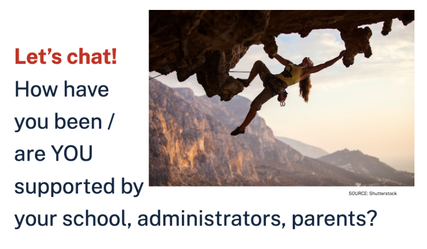
Day 2, May 28, 2020
Day 2 of the remote ZOOM conference began with Beata Mirecka-Jakubowska continuing the discussions from the previous day. All teachers shared their thoughts and feelings on the support they were expected to provide to the students and their parents. Also, the amount and type of support that the teachers were privy to was exchanged. We also discussed how teachers felt during the recent months of change from face-to-face delivery of content to totally remote. Some felt this shift was extremely difficult, but they somehow, amazingly, managed and by now felt more comfortable. Others were more experienced with online educational platforms and were able to make the adjustments more quickly and with less stress and hassle. This exchange provided very valuable insight into the diverse backgrounds of the participants and the range of experiences they encountered, especially in recent times.
An important element of the project is the exchange of good practices and creation of intellectual outcomes based on what we already know and use. Although most of the participating teachers weren’t certain whether the current online learning mode will continue or how long it will last, all participants agreed that the changes experienced by the students, teachers and parents have forever altered the status quo of so called “traditional teaching” and raised everyone’s awareness of what could be. Therefore, the question “What is working for your school/classroom right now that can be used again when face-to-face classes resume?” generated a lot of interesting ideas shared through the ZOOM chat.
Most of the thoughts focused on the use of technology when classes resume in the brick-and-mortar form:
TO ENHANCE STUDENT LEARNING
TO ENHANCE CLASSROOM MANAGEMENT
Additionally, teacher absence was brought up by Mark Cringle. Certainly, having experienced online learning, “when a teacher is absent from school for face-to-face interactions, class can have the lesson through ZOOM delivered by a teacher in a parallel class.”
Overall, the general impressions of the participants could be summarized in the statement by Ewelina Kaznowska, that when schools reopen, no matter whether completely face-to-face or with certain restrictions or alterations of the schedules, “students will expect a different dynamic from the teachers during the lessons. And maybe a more non-standard type of lesson.”
After a short break for a 60-second dance video to stretch and re-energize, the participants collaborated in a jigsaw activity, reading and commenting on the validity of claims in the Forbes.com article entitled “The Coronavirus Pandemic Has Unleashed A Revolution In Education: From Now On, Blended Learning Will Be The Benchmark.” Teachers were randomly assigned a paragraph to read and focus on a key point or two in a 30 second round-robin sharing session. After everyone had explained their take on the assigned piece of text (while also looking at the shared screen where the original text was displayed for easier reference - some of us are visual learners while others prefer auditory stimulus), the group subsequently discussed two intriguing questions.
Day 2 of the remote ZOOM conference began with Beata Mirecka-Jakubowska continuing the discussions from the previous day. All teachers shared their thoughts and feelings on the support they were expected to provide to the students and their parents. Also, the amount and type of support that the teachers were privy to was exchanged. We also discussed how teachers felt during the recent months of change from face-to-face delivery of content to totally remote. Some felt this shift was extremely difficult, but they somehow, amazingly, managed and by now felt more comfortable. Others were more experienced with online educational platforms and were able to make the adjustments more quickly and with less stress and hassle. This exchange provided very valuable insight into the diverse backgrounds of the participants and the range of experiences they encountered, especially in recent times.
An important element of the project is the exchange of good practices and creation of intellectual outcomes based on what we already know and use. Although most of the participating teachers weren’t certain whether the current online learning mode will continue or how long it will last, all participants agreed that the changes experienced by the students, teachers and parents have forever altered the status quo of so called “traditional teaching” and raised everyone’s awareness of what could be. Therefore, the question “What is working for your school/classroom right now that can be used again when face-to-face classes resume?” generated a lot of interesting ideas shared through the ZOOM chat.
Most of the thoughts focused on the use of technology when classes resume in the brick-and-mortar form:
TO ENHANCE STUDENT LEARNING
- using screencasting videos to help students complete homework or classwork:
- using interactive worksheets,
- implementing flipped classroom teaching,
- utilizing online platforms like Google classroom
- using Google drive as a storage for all materials for students
- using earth cams online
- showing youtube videos with native speakers explaining the grammar rules
TO ENHANCE CLASSROOM MANAGEMENT
- being more flexible,
- letting the children take charge of the direction of the learning
- experiencing better classroom discipline because students have seen that only one person can talk at the time
- organizing ZOOM meetings with parents or teachers to save time
- using the electronic grade book
Additionally, teacher absence was brought up by Mark Cringle. Certainly, having experienced online learning, “when a teacher is absent from school for face-to-face interactions, class can have the lesson through ZOOM delivered by a teacher in a parallel class.”
Overall, the general impressions of the participants could be summarized in the statement by Ewelina Kaznowska, that when schools reopen, no matter whether completely face-to-face or with certain restrictions or alterations of the schedules, “students will expect a different dynamic from the teachers during the lessons. And maybe a more non-standard type of lesson.”
After a short break for a 60-second dance video to stretch and re-energize, the participants collaborated in a jigsaw activity, reading and commenting on the validity of claims in the Forbes.com article entitled “The Coronavirus Pandemic Has Unleashed A Revolution In Education: From Now On, Blended Learning Will Be The Benchmark.” Teachers were randomly assigned a paragraph to read and focus on a key point or two in a 30 second round-robin sharing session. After everyone had explained their take on the assigned piece of text (while also looking at the shared screen where the original text was displayed for easier reference - some of us are visual learners while others prefer auditory stimulus), the group subsequently discussed two intriguing questions.
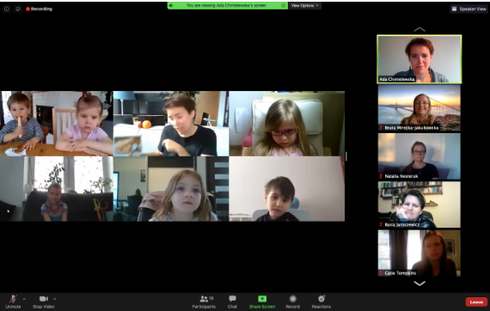
Again, much of the discussion oscillated around the use of technology and its careful, thoughtful, purposeful application in the learning process, to enhance the learning experience rather than to use tech for its own sake.
In the second half of the ZOOM session, Ada Chmielewska showed the participants segments of recorded online lessons with very young learners, illustrating how using props, real household items, flashcards and other paraphernalia helps students learn in a creative, interactive way. The entertainment element of the lessons certainly enhanced the length of time these young students were able to focus on the learning objective.
Teachers listened with interest how effectively even the youngest students can be persuaded to interact, to listen actively, and to use the words or phrases learned during an online lesson. The effects were really surprising and made everyone think about the possibilities of using the tools and methods presented by Ada and her team to work with children with low language skills (especially at level 0-1).
In the second half of the ZOOM session, Ada Chmielewska showed the participants segments of recorded online lessons with very young learners, illustrating how using props, real household items, flashcards and other paraphernalia helps students learn in a creative, interactive way. The entertainment element of the lessons certainly enhanced the length of time these young students were able to focus on the learning objective.
Teachers listened with interest how effectively even the youngest students can be persuaded to interact, to listen actively, and to use the words or phrases learned during an online lesson. The effects were really surprising and made everyone think about the possibilities of using the tools and methods presented by Ada and her team to work with children with low language skills (especially at level 0-1).
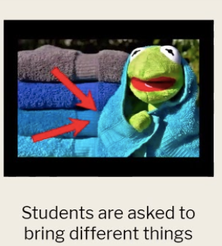
Particular attention was paid to the emotional involvement of the teachers conducting classes with young children. Ada and her colleagues also pointed out the role the image in the background of an online session could play - from a conversation starter to a part of the lesson. The use of everyday objects available at the home of every child participating in lessons was also noticed.
The presented recordings and the ability to track the positive reaction of preschoolers undoubtedly became an inspiration for some participants of the meeting, which was expressed in the comments during the chat discussion.
Overall, the first two meetings of the project team, forced into the online format by the pandemic, brought many benefits, both expected and unexpected as a result of the online meetings. Participants representing all partners in the project:
- learned more details about the organization of the project and its goals
- had the opportunity to share their observations and feelings about new methods and tools that were used in their language classes during pandemic lockdown
- summarized their own accelerated path of development imposed by school closure.
The presented recordings and the ability to track the positive reaction of preschoolers undoubtedly became an inspiration for some participants of the meeting, which was expressed in the comments during the chat discussion.
Overall, the first two meetings of the project team, forced into the online format by the pandemic, brought many benefits, both expected and unexpected as a result of the online meetings. Participants representing all partners in the project:
- learned more details about the organization of the project and its goals
- had the opportunity to share their observations and feelings about new methods and tools that were used in their language classes during pandemic lockdown
- summarized their own accelerated path of development imposed by school closure.
The exchange of experiences of teachers from different countries, representing various educational institutions, is undoubtedly an interesting experience. Participants felt the stimulus for the development of innovative methods of working with students, both online and offline when they return to face-to-face classes.
The two-day online conference has therefore been, under pandemic circumstances, a superb introduction to the project, which aims to strengthen the competence of early school education staff in the field of learning English.
At the next meeting in June, teachers from individual schools will share with their colleagues what tools worked best during the first stages of distance learning and will give each other recommendations in this regard.
The two-day online conference has therefore been, under pandemic circumstances, a superb introduction to the project, which aims to strengthen the competence of early school education staff in the field of learning English.
At the next meeting in June, teachers from individual schools will share with their colleagues what tools worked best during the first stages of distance learning and will give each other recommendations in this regard.













